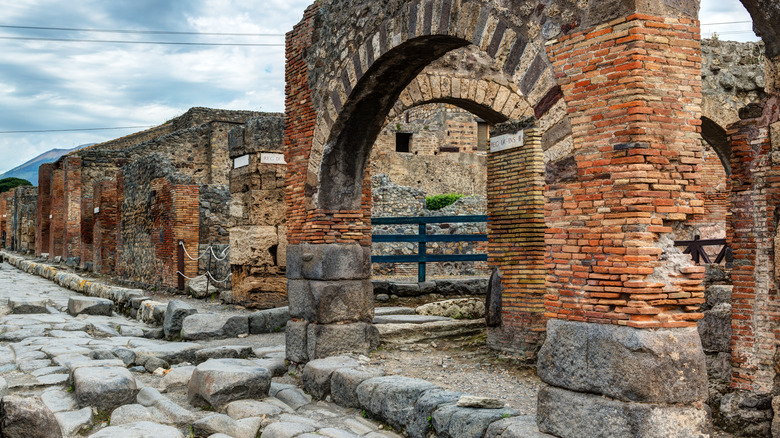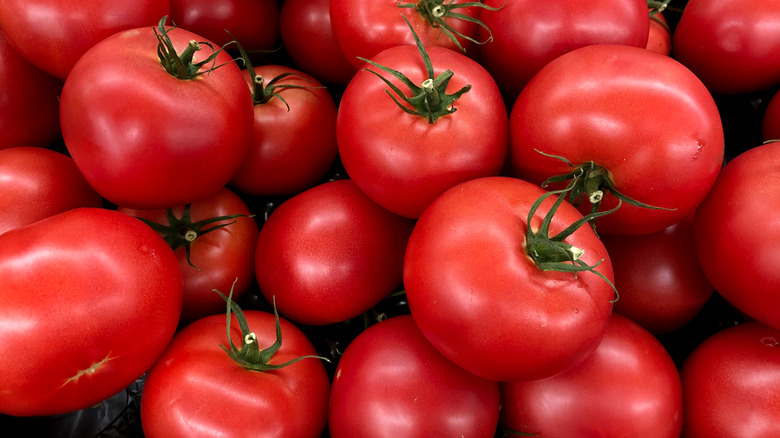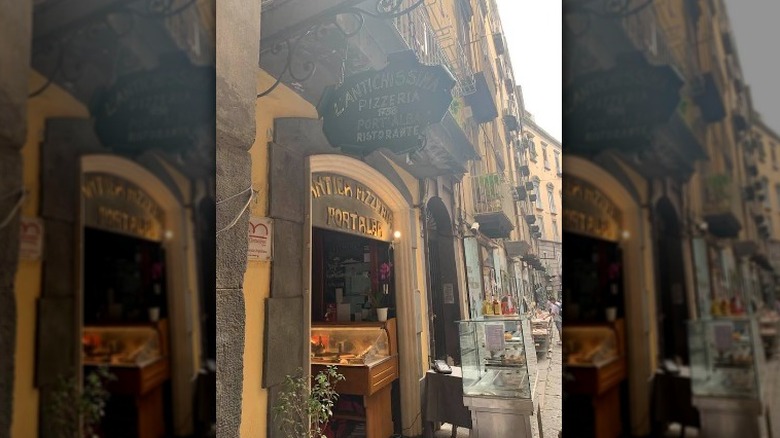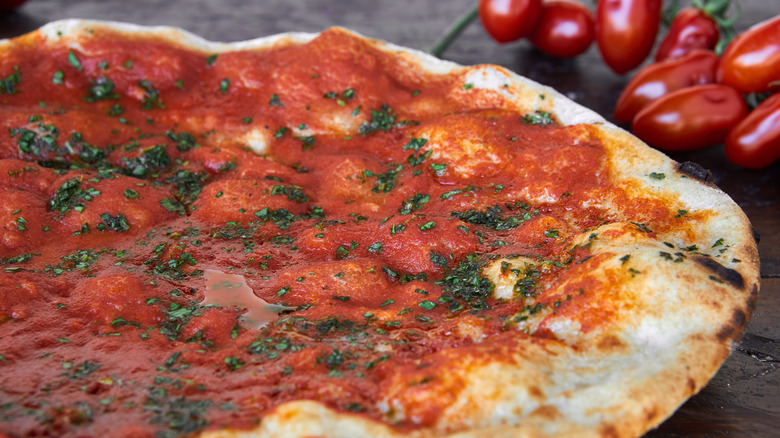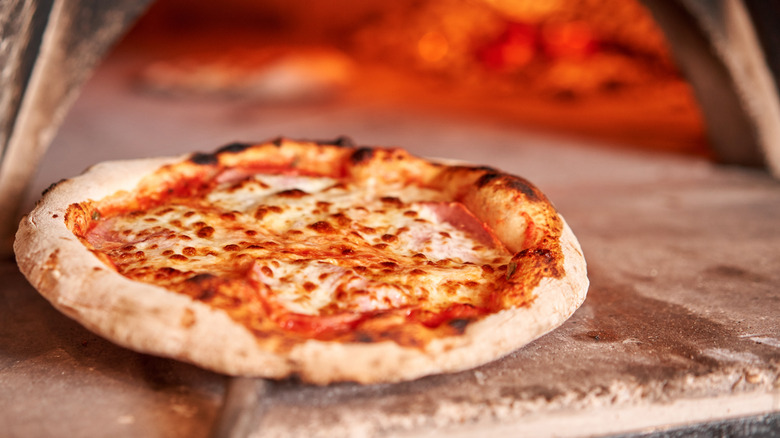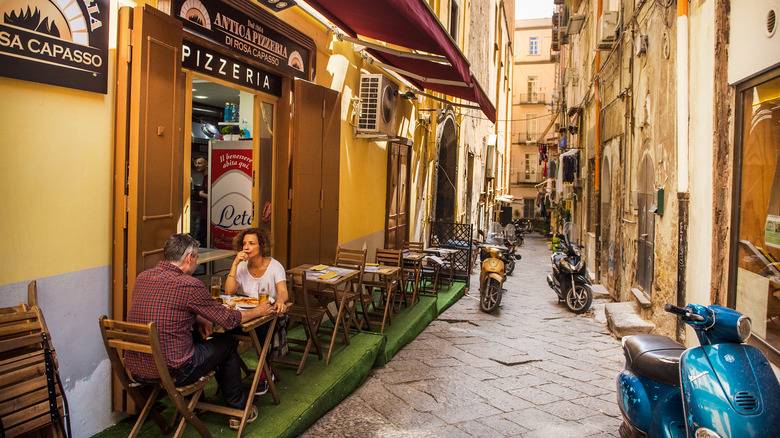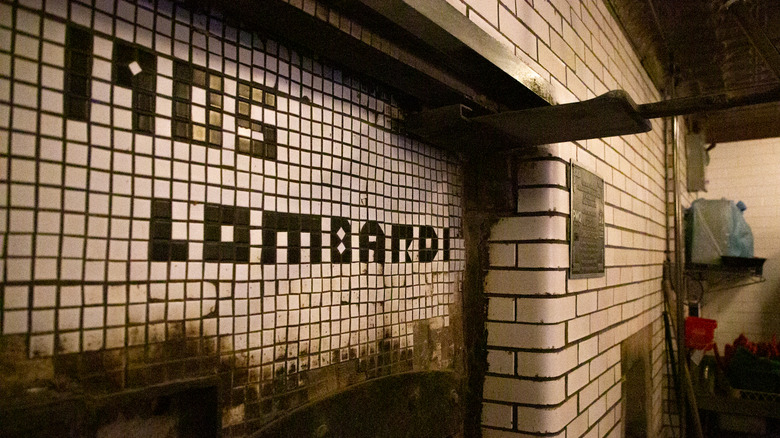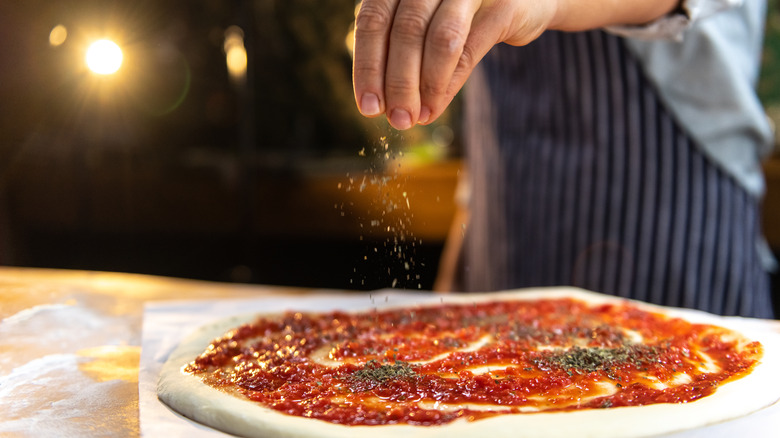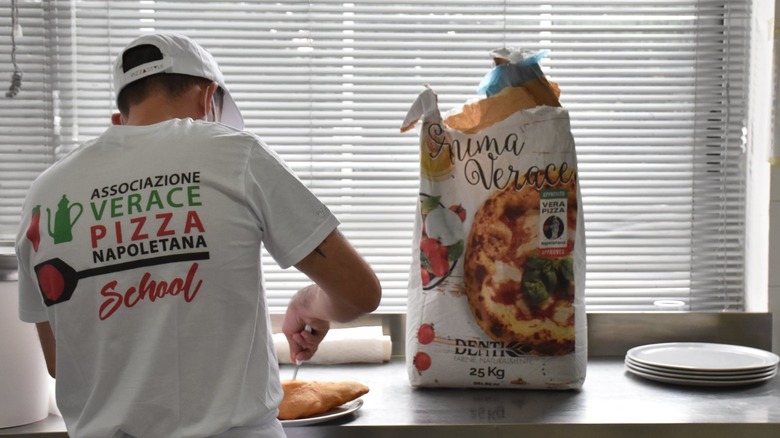The Secret History Of The First Pizza
Pizza is kind of a big deal. According to Statista, the global frozen pizza market is worth approximately $16.2 billion as of 2021, and that number is only expected to increase, rising to $23 billion by 2027. Restaurant pizza sales in the United States are valued at more than $46 billion, while quick-service pizza sales are valued at $203 million. Leading brands include household names such as DiGiorno, Mama Rosas, Domino's, and Papa John's.
Pizza has become ingrained in American culture just as much as apple pie, hot dogs, and hamburgers. When you want an easy party food that everyone will enjoy, you opt for pizza. When you need to feed a gaggle of kids, you go with pizza. When you want a late-night delivery of something to soak up the alcohol after a night out, you call for a pizza.
While pizza feels like an indelible part of American culture, it's really not. In fact, pizza is far older than America and didn't even really put down roots here until after World War II. So, before you grab that next slice, check out the real secret history of the first pizza and the long journey that brought it to American shores.
Pizza's precursors
Pizza goes way, way back. According to History, the OG pizza was more similar to a flatbread. Ancient Egyptians, Romans, and Greeks all ate some sort of version of bread covered in toppings, whatever best suited their region and culture. For example, the Greeks ate something that was essentially what we know today as focaccia, covered in herbs and oil.
What's Cooking America traces the history of pizza further, all the way back to the Stone Age, or about 2.6 million years ago when humans first started using stone tools before they switched over to bronze in 3,300 B.C. (via History). During this time, members of ancient civilizations in what is now Italy would cook a crude bread made from a dough consisting of just water and flour on fire-heated stones (similar to the process of using a baking stone and/or pizza oven for pizza today) and then season the bread with a variety of toppings. The bread would be eaten by hand, just like pizza.
Pizza gets mentioned a lot throughout history
How do we know about this historic pizza? Turns out, pizza-like dishes are mentioned a lot throughout history. What's Cooking America gives several examples.
In the third century B.C., Cato the Elder wrote a Roman history that included a description of a flat, round dough baked on stones and topped with olive oil, honey, and herbs. Virgil mentions similar Roman dough discs, thin and made from wheat, in "The Aeneid;" there, they're described as being eaten by hand and topped with "forest fruits." There was even a cookbook uncovered from the ruins of Pompeii that included a recipe for a circular dough topped with chicken, pine kernels, cheese, garlic, mint, pepper, and oil. Additionally, excavations at Pompeii have shown evidence of flat-baked flour cakes similar to pizza dough. It's no surprise that the more familiar and modern version of pizza would get its start in nearby Naples, which is less than a half-hour drive from the Pompeii ruins.
The tomato is introduced in the 1500s
What's one of the primary, requisite, must-have pizza toppings? As in, you cannot really have pizza unless you have this? You could say cheese, sure, but you also have to consider the sauce, and most pizzas include a tomato-based sauce. But tomatoes weren't always an approved food source, and they weren't even a thing in Europe until colonizers brought them back from the New World. In fact, as What's Cooking America notes, when tomatoes were first introduced to Europe, the general consensus was that the fruit was poisonous — and that's an interesting bit of food history in of itself.
Here's the deal: Wealthy Europeans used plates that contained lead, and the acidic tomatoes would draw the lead content out from the plates, resulting in lead poisoning for the unhappy diner (via Smithsonian Magazine). The impoverished populations of Europe did not have those fancy lead plates and so they discovered they could eat tomatoes without harm. Thus, the poorer citizens of Naples began adding tomatoes to their flatbreads, creating something that we would consider similar to today's pizza.
Pizza becomes popular
Through the 1700s and 1800s, pizza became increasingly popular with Naples' working poor. At the time, Naples was one of the largest cities in Europe (via History Today). A trade city on the coast, its population was ever-growing, with more and more of the population falling into poverty. Impoverished individuals known as lazzaroni would rush around the city looking for odd jobs wherever they could get them, and they needed food they could take with them on the go. Pizza, already historically an easy, affordable dish, fit the bill.
By this time, pizza was made with yeasted dough, much like today, and usually was topped with cheese, herbs, and, of course, tomatoes (via What's Cooking America). It was sold via street vendors who would carry boxes of pizza and then cut out slices to size as ordered. As pizza's popularity grew, so did the number of pizza toppings and the number of vendors.
The world's oldest pizzeria gets its start in 1738
It was around this time in 1738 that the oldest pizzeria in the world, Antica Pizzeria Port'Alba, got its start in Naples. According to the restaurant, at first, the pizzeria didn't sell to the public. Instead, it sold its pizzas to those aforementioned peddlers who would then take them around in boxes, hawking their wares to the lazzaroni. The pizzeria sold pies topped with tomatoes, tomato sauce, mozzarella, anchovies, and other fish. The restaurant's location right next to the city gates made it convenient for the peddlers, but then Antica Pizzeria Port'Alba expanded in 1830, opening in more of a traditional restaurant-style, selling to the public and offering on-site dining with tables and chairs. It also expanded its menu to include pasta and seafood dishes.
Today you can find many of those same items on the menu, including pizzas topped with anchovies, mozzarella, basil, olive oil, and those suspicious tomatoes.
Pizza classics make their debut
Antica Pizzeria Port'Alba isn't only famous for being the very first and oldest pizzeria in the world. This restaurant also claims to be the birthplace of pizza varieties and topping options that are now classics, such as the marinara pizza, which is hugely popular in Naples and Italy.
According to the BBC, the pizzeria created the marinara pizza, which is topped with tomato sauce and garlic (and occasionally other herbs), to meet the demand of the poorest of the poor: sailors. In fact, the word "marinara" stems from the Italian word "marinaio," which means "sailor." Sailors would come into the pizzeria on days when they failed to reel in a good catch and spend their little money on a marinara pizza, which they could top with small fish.
However, while Antica Pizzeria Port'Alba can lay claim to the marinara pizza, it cannot take credit for the even more widely known Margherita pizza.
Margherita pizza is "invented" in 1889
Everyone knows that a Margherita pizza is pretty basic. It's just cheese, basil, and tomatoes. And, because it's so simple, we can't really say it was "invented" in 1889, and it's even a little risky crediting the invention to any particular pizzaiolo (the Italian term for a pizza chef), but, in the history of pizza, this is considered the time and place where Margherita pizza got its iconic name.
The story goes, according to What's Cooking America, that the then-king and queen of Italy, Umberto I and Margherita di Savoia, visited Naples, where tavern-owner Raffaele Esposito prepared three different pizza options for the pair. The queen liked the pizza with mozzarella, basil, and tomatoes most, so much so that she sent Esposito a letter to thank him for it afterward, and the pizza was thereafter known as the pizza Margherita.
Italy Magazine does admit there are historical records that describe a pizza with tomato, mozzarella, and basil being made and sold prior to this, but the above story is what made this particular type of pizza famous. Today, the pizza Margherita, the Margherita extra, and Antica Pizzeria Port'Alba's marinara pizza are considered the three "traditional" Neapolitan pizzas.
Neapolitan pizza makes its way into literature
The word about Neapolitan pizza quickly spread. This was too good a dish to be left to the poverty-stricken masses — the Italian Queen, after all, was eating pizza. Throughout the 19th century, pizza found its way into many a piece of literature after various novelists and writers found themselves in Italy. Alexandre Dumas, who penned "The Three Musketeers," wrote, "The pizza is a kind of talmouse [triangular cheese pastry] like the ones they make in Saint-Denis. It is round, and kneaded from the same dough as bread ... There are pizzas with oil, pizzas with different kinds of lard, pizzas with cheese, pizzas with tomatoes, and pizzas with little fish" (via SBS).
Not every writer was kind to Neapolitan pizza, though. Carlo Collodi, known for writing "The Adventures of Pinocchio," said, "Do you want to know what pizza is? It is a focaccia made from leavened bread dough which is toasted in the oven. On top of it they put a sauce with a little bit of everything. When its colors are combined — the black of the toasted bread, the sickly white of the garlic and anchovy, the greeny-yellow of the oil and fried greens, and the bits of red here and there from the tomato — they make pizza look like a patchwork of greasy filth that harmonizes perfectly with the appearance of the person selling it."
Pizza remains mostly in Italian kitchens until the early 1900s
Maybe the negative late 19th-century accounts of pizza held the pie back a bit, because, by the time the 20th century dawned, pizza was still primarily only found in Italian kitchens. According to the pizza-ordering app Slice, pizza came to the United States in the late 1800s as droves of Italian immigrants made their way to cities such as New York, Philadelphia, and Boston. It would take a few decades until Americans embraced pizza on their own terms.
Even in Italy, it took a while for pizza to spread from Naples to other regions of the country. As History Today notes, pizza wasn't really a thing throughout the rest of Italy until Neapolitans began moving northward in search of work in the 1930s. They took their pizza along with them. Additionally, as more foreigners traveled to Italy over the course of World War II and afterward, these foreign diners started asking for the Neapolitan specialty in restaurants throughout the entire country — and enterprising restaurateurs obliged them.
American pizza is first mentioned in 1904
The first recorded instance of pizza being served in America was in 1904, says Slice, when an article in The Boston Journal credited two Boston brothers with bringing pizza to America for the first time, though this claim is questionable. However, we do know that, just a year later, Lombardi's, the recognized oldest pizzeria in America was established in New York City (via Thrillist). Many other iconic pizzerias would quickly follow, opening their doors on the East Coast.
The longest continuously-running and family-owned pizzeria opened in 1912, in Trenton, New Jersey. Papa T's Tomato Pies became known for selling the unique "tomato pie" pizza variant that differs slightly from traditional pizza in that its toppings are layered in reverse order: cheese, then toppings, then tomato sauce (via What's Cooking America). Pizzerias continued to pop up along the East Coast in immigrant communities until, eventually, American restaurateurs began putting their own spin on the dish.
World War II changes American pizza forever
If you're making your own pizza sauce, or any Italian-style dish, for that matter, chances are good you're going to reach into your spice cabinet at some point and pull out some oregano. However, up until World War II, oregano was not something you'd find on American pizza, or even in traditional Italian tomato sauce created by Italian-Americans. During the war, though, American troops came into contact with oregano in Southern Italy, where many — especially those who lived nowhere near the Italian immigrant communities of the East Coast — also tried pizza and other Italian fare for the first time (via NPR).
When the troops came back home, they wanted their oregano to come too, and in the decade following the war, oregano sales in the United States leapt by 5,200%. The increased demand for oregano coincided with increased demand for pizza, wherever returning vets could get it, authentic or not.
Preserving the "real" and "first" pizza
Pizza's come a long, long way from that basic and humble dish that served Naples' poor so well. However, there are some steadfast communities out there who want to ensure that the world doesn't forget the "real" and "true" first pizza of the world. The True Neapolitan Pizza Association, formed in the 1980s, is one of those communities. The Association staunchly protects the definition of what is considered true Neapolitan pizza, and what differentiates this "true" pizza from its brethren.
According to the Association, a true Neapolitan pizza is round-ish, with a maximum diameter of 35 centimeters and a raised edge that's swollen, free from burns, and 1 to 2 centimeters thick. The dough should be soft, fragrant, and made with one liter of water, 40 to 60 grams of salt, varying portions of yeast dependent on the type used, and 1,600–1,800 grams of flour. The ingredients must be mixed, fermented, and matured before the pizza base is formed. The toppings should be sourced from the Campania region. Toppings include tomato, cheese, basil, and olive oil. The Association even hosts a school on the topic.
If you don't want to go through the trouble of making a "real" historically-accurate pizza yourself, you can always use the Association's handy search function to find an authentic and approved pizzeria near you.


